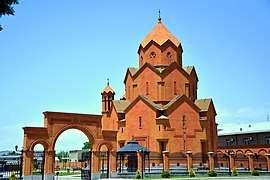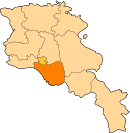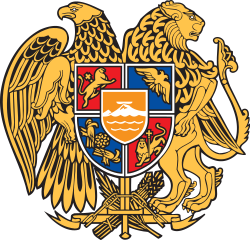Masis, Armenia
Masis (Armenian: Մասիս), is a town and urban municipal community in the Ararat Province of Armenia, located on the left bank of the Hrazdan River, 9 km southwest of Yerevan towards Mount Ararat. The town has a large railroad commodity station that serves Yerevan, and used to connect the capital city with the Nakhichevan Autonomous Soviet Socialist Republic until the closing of the border with Azerbaijan.
- For the nearby village called Masis, see Masis (village).
Masis Մասիս | |
|---|---|
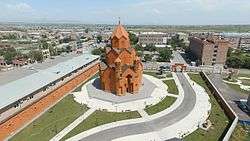 The centre of Masis with Saint Thaddeus Church | |
Coat of arms | |
 Masis Մասիս | |
| Coordinates: 40°00′50″N 44°29′09″E | |
| Country | |
| Marz | Ararat |
| Founded | 1953 |
| Area | |
| • Total | 5.7 km2 (2.2 sq mi) |
| Elevation | 854 m (2,802 ft) |
| Population (2011 census) | |
| • Total | 20,215 |
| • Rank | Armenia: 15th |
| • Density | 3,500/km2 (9,200/sq mi) |
| Time zone | UTC+4 ( ) |
| Area code(s) | +374(236) |
| Website | Official website |
| Sources: Population[1] | |
Masis is one of the closest settlements to Mount Ararat and Little Ararat. The mountains are visible from most of the areas in the town.
As of the 2011 census, the population of the town was 20,215. As per the 2016 official estimate, the town has a population of 18,500.
Etymology
Masis (Armenian: Մասիս) is the Armenian name for the peak of Mount Ararat.[2] The History of Armenia derives the name from king Amasia, the great-grandson of the Armenian patriarch Hayk, who is said to have called the mountain Masis after his own name.[2]
History
Historically, the territory of modern-day Masis was included within the Vostan Hayots canton of the historical province of Ayrarat of Ancient Armenia.
Masis was officially founded by the Soviet government in 1953 as Hrazdan, after the merger of the villages of Narimanlu, Zangibasar, and Ulukhanlu. In 1969 the settlement was renamed Masis to become the centre of the re-founded Masis raion (formerly known as Zangibasar raion form 1937 until it was abolished in 1953). Within 2 years, Masis was given the status of an urban-type settlement in 1971.
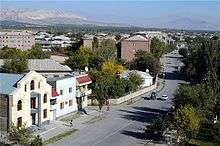
The settlement was developed as centre for agricultural products and light industries during the Soviet years. It gradually became home to many large firms including the Al. Miasnikian furniture factory, the Masis unit of the Yerevan carpet weaving factory, as well as branch of the Yerevan paper manufacturing plant.
After the dissolution of the Soviet Union, Masis was granted the status of a town within the newly-formed Ararat Province, based on the new law of the territorial administration of the Republic of Armenia passed in 1995.
Masis is connected with a number of villages stretching up to the Aras River at the border with Turkey. At nights, one can see the lights of many Kurdish villages on the slopes of Mount Ararat in Turkey.
Geography

Masis is located in the Ararat plain on the left bank of Hrazdan River, 16 km southwest of Yerevan on the road to the ancient city of Artashat. It has an average height of 854 meters above sea level.
Summer in general is short but hot in Masis, while winter is relatively long and very cold.
Demographics
Population
The majority of the population in Masis are ethnic Armenians who arrived in the area from the Iranian cities of Khoy and Salmas, after the Russo-Persian War of 1826–28.
Here is the population timeline of Masis since 1959:.[3]
| Year | 1959 | 1970 | 1975 | 1980 | 2001 | 2011 | 2016 |
|---|---|---|---|---|---|---|---|
| Population | 3,138 | 4,961 | 8,142 | 13,248 | 21,376 | 20,215 | 18,500 |
Religion
The vast majority of the population in Masis belong to the Armenian Apostolic Church. The regulating body of the church is the Araratian Pontifical Diocese, headed by Archbishop Navasard Kchoyan (seat in Yerevan).
The small church of Saint George opened in 2009, was the first church of Masis. However, the town's main church is the church of Saint Thaddeus, consecrated on October 4, 2015, by Catholicos of All Armenians Garegin II. The foundations of the church were laid in 1991. In 2005 the construction of the church was initiated and financed by philanthropist Hrant Vardanyan, and all the construction works were completed by his sons Mikayel and Karen.
Culture
Masis has a 16th-century chapel named after Saint Thaddeus, and a 19th-century church known as the Holy Mother of God.
Currently, the town has a public library and a music school named after Arno Babajanian.
The World War II monument erected in 1983 is one of the main landmarks of Masis.
Transportation
Masis has a railway station since the formation of the town. It used to connect Yerevan with Nakhchivan as well as Iran during the Soviet era. However, after the dissolution of the USSR, the station was abandoned.
The M-2 Motorway that connects the capital Yerevan with southern Armenia, passes through the eastern borders of the town of Masis.
Economy
.jpg)
The industrial district of Masis occupies the western half of the town. Unfortunately, most of the Soviet industry in Masis was abandoned after the independence of Armenia. However, Masis is currently a major centre for tobacco products in Armenia and Transcaucasia, with 2 giant manufacturers: Masis Tobacco factory (since 1999) and International Masis Tabak factory (since 2002).
It is also home to the Grand Master corrugated cardboard packaging manufacturing and label printing factory (since 1995), Masis Garun knitting factory (since 1995), Berma company for construction and building materials (since 1997), Masis Woodcraft factory (since 2004), Medical Horizons pharmaceuticals factory (since 2005),[4] Masis Woodworking Center, and Sonomad plant for building materials .
Masis is home to the largest slaughterhouse in Armenia, the Voske Katsin Armenian-Iranian joint-venture.[5] It was founded in 2015 and became the first slaughterhouse in Armenia that provides its products with the Halal certification.[6]
Education
As of 2017, Masis has 6 public education schools and 6 kindergartens. It is also home to the Masis State Agricultural College.
Sport
Masis FC represented the town in the domestic football competitions until 1994 when the club was dissolved due to financial difficulties.
The Masis Children and Youth Sports School named after Armen Nazaryan was opened in September 2016.[7]
On March 28, 2017, the construction of a new sports centre was launched in the town of Masis, with the donation of the Adibekyan Family Foundation for Advancement (AFFA).[8] The centre which is set to be completed in June 2018 with a cost of US$2 million, will have fields for mini-football, basketball, outdoors sports, as well as a children's playground and a social family club.[9]
Notable people
- Armen Nazaryan, two-time Olympic Greco-Roman Wrestling Champion with Armenia and Bulgaria
- Khagani Mammadov, Azerbaijani retired footballer
See also
- Gortsaranayin Street in Masis town, Republic of Armenia, was renamed after Hrant Vardanyan on February 5, 2019.
- Masis (village)
References
| Wikimedia Commons has media related to Masis. |
- 2011 Armenia census, Ararat Province
- Thomson, p. 90-98.Thomson 1978
- "Հայաստանի հանրապետության բնակավայրերի բառարան, էջ 6" (PDF). Retrieved 2015 Մայիսի 131. Check date values in:
|accessdate=(help) - Medical Horizons pharmaceuticals
- «Ոսկե կացին»-ը բացել է հանրապետության ամենախոշոր սպանդանոցը
- Voske Katsin Armenian-Iranian joint-venture
- Մասիսում բացվեց Օլիմպիական չեմպիոն Արմեն Նազարյանի անվան մարզադպրոցը
- A new sport centre in Masis
- President Serzh Sargsyan's working visit to Ararat Marz
